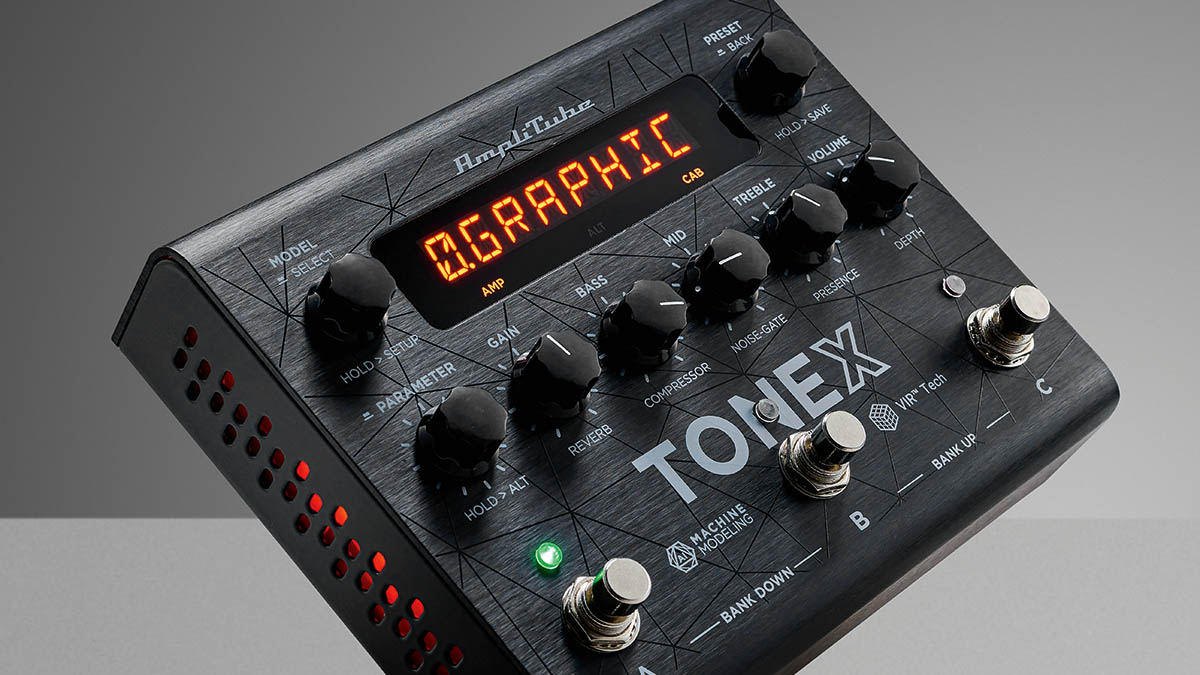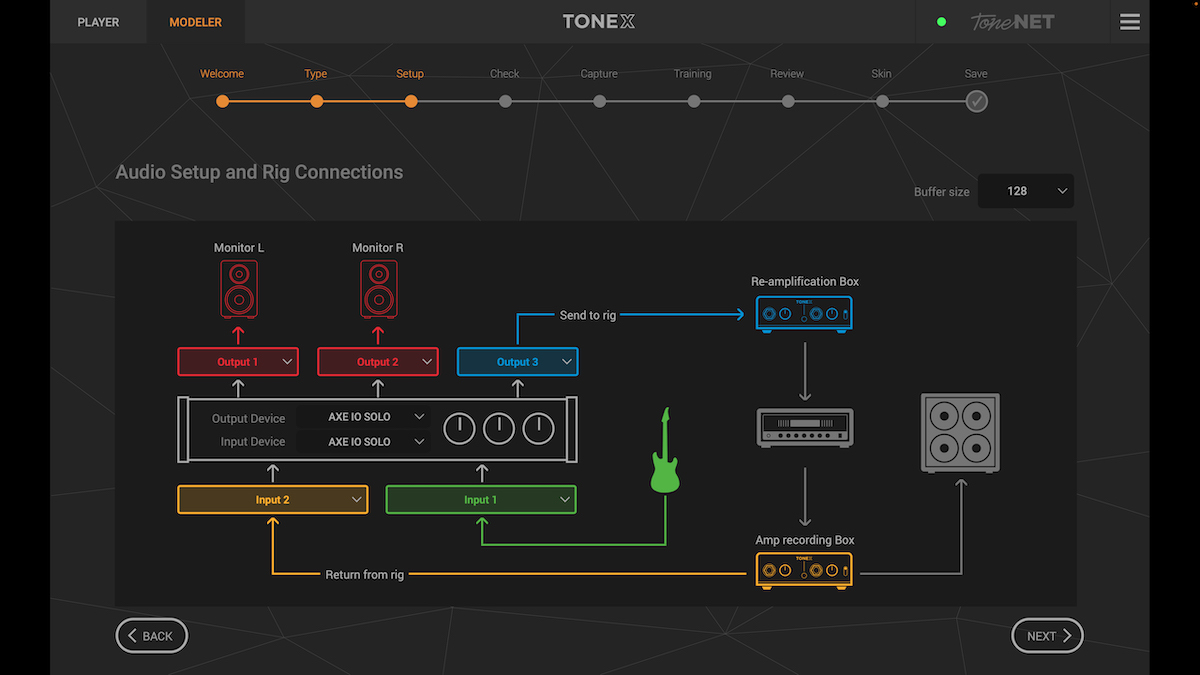I’ve played IK Multimedia’s nano modeling amp, the TONEX One – and it could be the ultimate pocket-sized pedal platform
The tiny modeler is not perfect, but it’s going to solve a lot of problems – particularly for players who are willing to put in a little time upfront

Flow is one of the most important aspects of guitar playing. As a composer or player, it’s part of the allure of playing the instrument. Finding that rich, trance-like state where you puzzle out a musical idea or learn a scale or a riff is addictive.
Although it's rarely stated in these terms, the signal purist versus pedal junkie debate really comes down to its relationship with that sense of flow. Is any new addition to your signal chain worth the trade-off in breaking flow? Does it propel your playing and solve problems, or does it put up barriers and distract you?
Not everyone can (or should) stomach the direct approach of a straight-to-amp signal path, of course, but even when it comes to pedals, flow is the reason that stompboxes have stubbornly remained the leading form factor for guitar processing.
The ergonomic interaction with pedals beats most other solutions. It’s why they’ve survived where rack equipment has not – and remain the preference of many players who can easily access limitless tones by menu-diving on a DAW or an app.
All of which brings me on to the TONEX One – a new pedal from IK Multimedia that effectively does a bit of both – shrinking its impressive AI-powered TONEX platform and vast preset options into a tiny nano-sized pedal enclosure. It promises to be a best of both worlds, but can that ever really be the case?
The trade-off is that now some features are only accessible via the software editor. However, there are thousands of tone models available online and 20 built-in presets on the unit itself.
Out of the box, the pedal is set up in A/B mode meaning that, in the manner of an amp, it’s always on. You can, of course, switch this to Stomp mode should you want to disengage/engage at will.
Get The Pick Newsletter
All the latest guitar news, interviews, lessons, reviews, deals and more, direct to your inbox!

By default, the first channel is a Fender-ish clean and the second is a Marshall-like gain stage. The gain channel offers the three-band EQ and gain/volume control on the front panel, while the alt switch allows access to additional parameters – gain, gate, comp and reverb. Here, the design of the front panel is well thought-out, with the font weight showing which parameters are active.
Of the stock A/B settings, the clean model is the better of the two. The gain channel is a touch too tame compared to its inspiration (though, as mentioned, there are 20 presets available to browse on the unit itself, so you won’t struggle for alternatives).
I set up the Fender-style model with a slightly dirty sound to get some ideas down – and quickly nail some great blues tones.
This might be where the pedal's true niche lies – as a pocket-sized pedal platform amp
Using it as a base layer for drive pedals works really well, too. Adding a trusty Smallsound/Bigsound mini in front gives the second channel-style push I need and it handles it ably, reacting in a satisfyingly amp-like way.
The usual caveats of needing to tweak EQ and levels to suit the drive pedals you're stacking into it apply here, but this might be where the pedal's true niche lies – as a pocket-sized pedal platform amp. It’s also where it best complements that state of ‘flow’ and, essentially, gets out of the way of your playing.
That said, flow is also at the heart of any gripe I have with the TONEX.
At the point where you hit the limit of what it can do, and need to replace those presets, you're reaching for a USB cable. I don’t want to sound too dramatic, but the ritual of getting out the laptop and fussing around software makes it feel like filling in a spreadsheet at work. And database entry is not renowned for its inspirational qualities.

Arguably, though, that is a moot point: if you're buying a modeling pedal this small, then you already know that there's going to be an ergonomic trade-off. Once you reach the limits of those presets then a lot is going to come down to how you feel about cracking out the USBs.
Luckily, IK knows how to make good, ergonomic software, so the pain is minimal once you're plugged in. Moreover, if you were to use the TONEX as a pedal platform, you would only have to do this once, to find and setup the voicings that suit you. After that, it's a case of set-and-forget.
So, while it's nice to have endless options at your fingertips, the practical restriction of two A/B models isn't a massive drawback. After all, many non-modeling players will be familiar with that dilemma on a traditional tube amp.
The TONEX can bring both Fender and Marshall (and many, many, more) models to your pedalboard, and it can fit in your pocket
My testing Marshall stack certainly doesn't have the flexibility of the TONEX One – and the TONEX can bring both Fender and Marshall (and many, many, more) models to your pedalboard, and it can fit in your pocket.
There are inevitably going to be endless YouTube gear videos with 'game changer' in the title, so what's our verdict? Well, it's not a game-changer, but it is good.
As I noted with Fender’s Tone Master Pro, we're very much in incremental improvement territory when it comes to modeling’s tonal qualities. The main distinguishing factors in 2024 are practicality and usability – and the TONEX One has an abundance of the former and enough of the latter.
Ultimately, it comes down to how you use it. It is ridiculously small, sounds as good as the larger stompboxes, and the software is solid. Is it as ergonomic as having an amp next to you with every parameter instantly accessible? No. But it's flexible and compact [and if you want more control there’s always the TONEX Pedal - Ed].
Even if you take the view that you may as well just take a laptop with you, then the TONEX doubles as a compact interface for recording. Or, used with headphones, as a quiet home or travel practice solution.
At $179.99, it could also work well as the basis for an affordable fly rig pedalboard or quiet stage solution. Notably, given you can clone your own gear using the TONEX software, it’s also an appealing one-stop back-up option for any physical amps or drive pedals. And it has a tuner.
When it comes to that core question of flow – of whether it helps or hinders – then this is not one of those boxes that is an immediate playing enhancer, but if you have a purpose for it and put in a little time upfront, well, it can certainly solve some problems – and might just be the ultimate mini-pedal pedal platform.
- For more information on the TONEX One, head to IK Multimedia.
UPDATE 04/24/24: This article was updated to underline the fact that TONEX One comes with 20 onboard presets (available without connection via USB to the software editor) and removed mention of a lack of manual, given the full version was unavailable at the time of testing.
Alex Lynham is a gear obsessive who's been collecting and building modern and vintage equipment since he got his first Saturday job. Besides reviewing countless pedals for Total Guitar, he's written guides on how to build your first pedal, how to build a tube amp from a kit, and briefly went viral when he released a glitch delay pedal, the Atom Smasher.
“If you’re a young guitar player, that’s money well spent”: John Mayer names the pedal he thinks every young guitar player should consider buying
“An effortless way to customize your TONEX pedals for the stage”: IK Multimedia answers players’ prayers and gives its best-selling TONEX units their biggest upgrade to date – a dedicated editor










